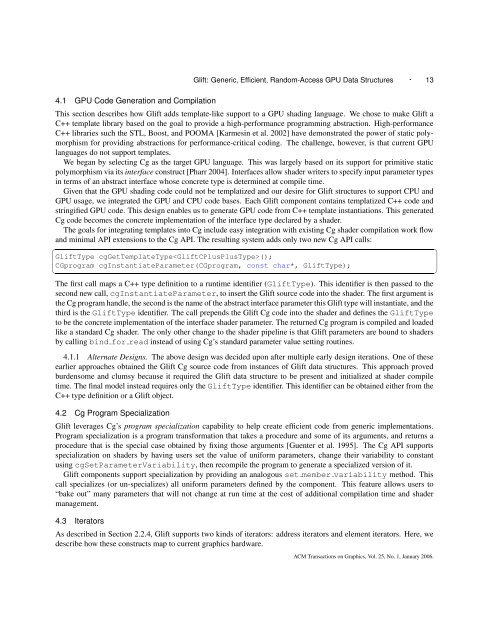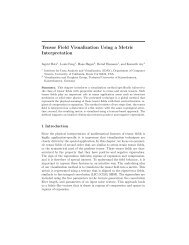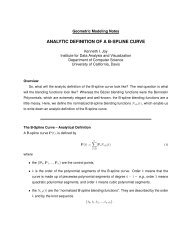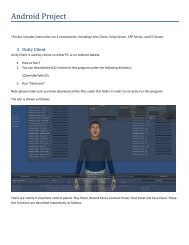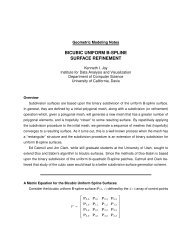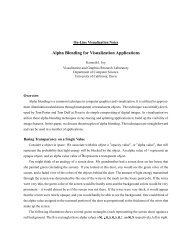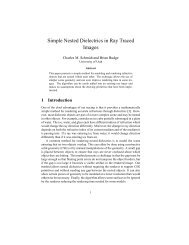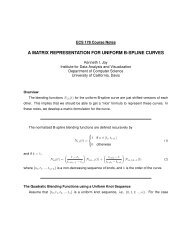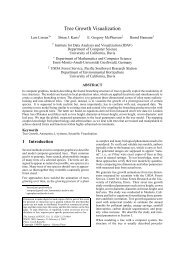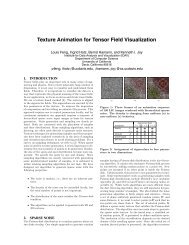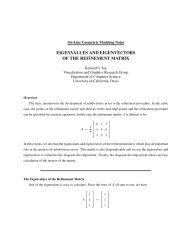Paper - IDAV: Institute for Data Analysis and Visualization
Paper - IDAV: Institute for Data Analysis and Visualization
Paper - IDAV: Institute for Data Analysis and Visualization
You also want an ePaper? Increase the reach of your titles
YUMPU automatically turns print PDFs into web optimized ePapers that Google loves.
Glift: Generic, Efficient, R<strong>and</strong>om-Access GPU <strong>Data</strong> Structures · 134.1 GPU Code Generation <strong>and</strong> CompilationThis section describes how Glift adds template-like support to a GPU shading language. We chose to make Glift aC++ template library based on the goal to provide a high-per<strong>for</strong>mance programming abstraction. High-per<strong>for</strong>manceC++ libraries such the STL, Boost, <strong>and</strong> POOMA [Karmesin et al. 2002] have demonstrated the power of static polymorphism<strong>for</strong> providing abstractions <strong>for</strong> per<strong>for</strong>mance-critical coding. The challenge, however, is that current GPUlanguages do not support templates.We began by selecting Cg as the target GPU language. This was largely based on its support <strong>for</strong> primitive staticpolymorphism via its interface construct [Pharr 2004]. Interfaces allow shader writers to specify input parameter typesin terms of an abstract interface whose concrete type is determined at compile time.Given that the GPU shading code could not be templatized <strong>and</strong> our desire <strong>for</strong> Glift structures to support CPU <strong>and</strong>GPU usage, we integrated the GPU <strong>and</strong> CPU code bases. Each Glift component contains templatized C++ code <strong>and</strong>stringified GPU code. This design enables us to generate GPU code from C++ template instantiations. This generatedCg code becomes the concrete implementation of the interface type declared by a shader.The goals <strong>for</strong> integrating templates into Cg include easy integration with existing Cg shader compilation work flow<strong>and</strong> minimal API extensions to the Cg API. The resulting system adds only two new Cg API calls:✞GliftType cgGetTemplateType();CGprogram cgInstantiateParameter(CGprogram, const char*, GliftType);✝The first call maps a C++ type definition to a runtime identifier (GliftType). This identifier is then passed to thesecond new call, cgInstantiateParameter, to insert the Glift source code into the shader. The first argument isthe Cg program h<strong>and</strong>le, the second is the name of the abstract interface parameter this Glift type will instantiate, <strong>and</strong> thethird is the GliftType identifier. The call prepends the Glift Cg code into the shader <strong>and</strong> defines the GliftTypeto be the concrete implementation of the interface shader parameter. The returned Cg program is compiled <strong>and</strong> loadedlike a st<strong>and</strong>ard Cg shader. The only other change to the shader pipeline is that Glift parameters are bound to shadersby calling bind <strong>for</strong> read instead of using Cg’s st<strong>and</strong>ard parameter value setting routines.4.1.1 Alternate Designs. The above design was decided upon after multiple early design iterations. One of theseearlier approaches obtained the Glift Cg source code from instances of Glift data structures. This approach provedburdensome <strong>and</strong> clumsy because it required the Glift data structure to be present <strong>and</strong> initialized at shader compiletime. The final model instead requires only the GliftType identifier. This identifier can be obtained either from theC++ type definition or a Glift object.4.2 Cg Program SpecializationGlift leverages Cg’s program specialization capability to help create efficient code from generic implementations.Program specialization is a program trans<strong>for</strong>mation that takes a procedure <strong>and</strong> some of its arguments, <strong>and</strong> returns aprocedure that is the special case obtained by fixing those arguments [Guenter et al. 1995]. The Cg API supportsspecialization on shaders by having users set the value of uni<strong>for</strong>m parameters, change their variability to constantusing cgSetParameterVariability, then recompile the program to generate a specialized version of it.Glift components support specialization by providing an analogous set member variability method. Thiscall specializes (or un-specializes) all uni<strong>for</strong>m parameters defined by the component. This feature allows users to“bake out” many parameters that will not change at run time at the cost of additional compilation time <strong>and</strong> shadermanagement.4.3 IteratorsAs described in Section 2.2.4, Glift supports two kinds of iterators: address iterators <strong>and</strong> element iterators. Here, wedescribe how these constructs map to current graphics hardware.ACM Transactions on Graphics, Vol. 25, No. 1, January 2006.☎✆


